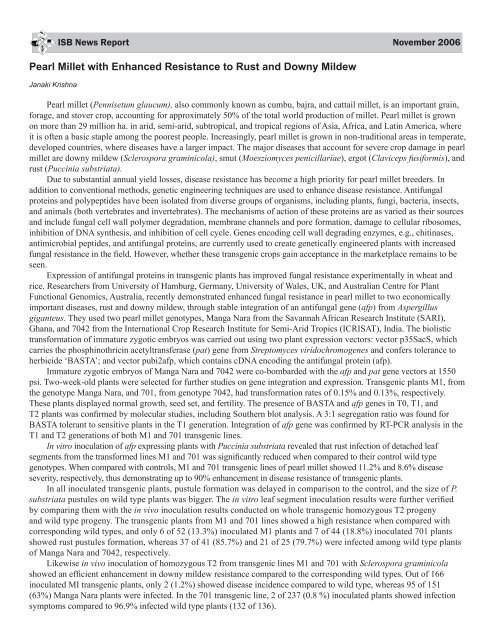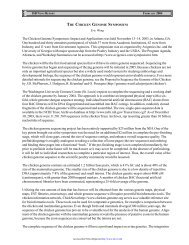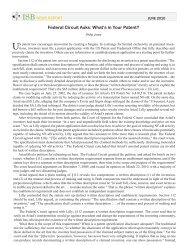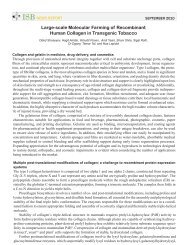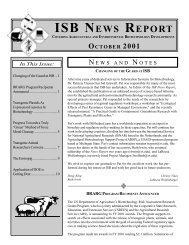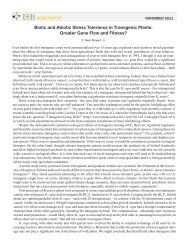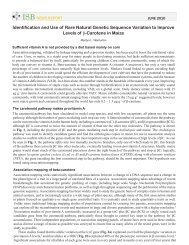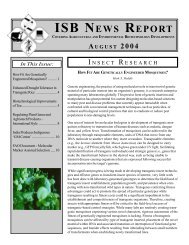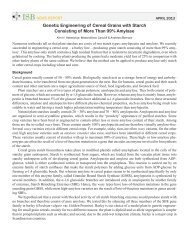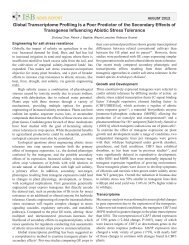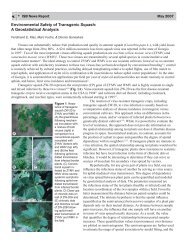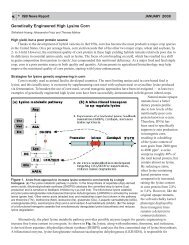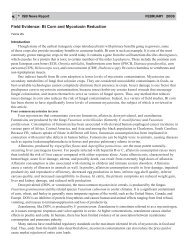Pearl Millet with Enhanced Resistance to Rust and Downy Mildew
Pearl Millet with Enhanced Resistance to Rust and Downy Mildew
Pearl Millet with Enhanced Resistance to Rust and Downy Mildew
You also want an ePaper? Increase the reach of your titles
YUMPU automatically turns print PDFs into web optimized ePapers that Google loves.
ISB News Report November 2006<br />
<strong>Pearl</strong> <strong>Millet</strong> <strong>with</strong> <strong>Enhanced</strong> <strong>Resistance</strong> <strong>to</strong> <strong>Rust</strong> <strong>and</strong> <strong>Downy</strong> <strong>Mildew</strong><br />
Janaki Krishna<br />
<strong>Pearl</strong> millet (Pennisetum glaucum), also commonly known as cumbu, bajra, <strong>and</strong> cattail millet, is an important grain,<br />
forage, <strong>and</strong> s<strong>to</strong>ver crop, accounting for approximately 50% of the <strong>to</strong>tal world production of millet. <strong>Pearl</strong> millet is grown<br />
on more than 29 million ha. in arid, semi-arid, subtropical, <strong>and</strong> tropical regions of Asia, Africa, <strong>and</strong> Latin America, where<br />
it is often a basic staple among the poorest people. Increasingly, pearl millet is grown in non-traditional areas in temperate,<br />
developed countries, where diseases have a larger impact. The major diseases that account for severe crop damage in pearl<br />
millet are downy mildew (Sclerospora graminicola), smut (Moesziomyces penicillariae), ergot (Claviceps fusiformis), <strong>and</strong><br />
rust (Puccinia substriata).<br />
Due <strong>to</strong> substantial annual yield losses, disease resistance has become a high priority for pearl millet breeders. In<br />
addition <strong>to</strong> conventional methods, genetic engineering techniques are used <strong>to</strong> enhance disease resistance. Antifungal<br />
proteins <strong>and</strong> polypeptides have been isolated from diverse groups of organisms, including plants, fungi, bacteria, insects,<br />
<strong>and</strong> animals (both vertebrates <strong>and</strong> invertebrates). The mechanisms of action of these proteins are as varied as their sources<br />
<strong>and</strong> include fungal cell wall polymer degradation, membrane channels <strong>and</strong> pore formation, damage <strong>to</strong> cellular ribosomes,<br />
inhibition of DNA synthesis, <strong>and</strong> inhibition of cell cycle. Genes encoding cell wall degrading enzymes, e.g., chitinases,<br />
antimicrobial peptides, <strong>and</strong> antifungal proteins, are currently used <strong>to</strong> create genetically engineered plants <strong>with</strong> increased<br />
fungal resistance in the field. However, whether these transgenic crops gain acceptance in the marketplace remains <strong>to</strong> be<br />
seen.<br />
Expression of antifungal proteins in transgenic plants has improved fungal resistance experimentally in wheat <strong>and</strong><br />
rice. Researchers from University of Hamburg, Germany, University of Wales, UK, <strong>and</strong> Australian Centre for Plant<br />
Functional Genomics, Australia, recently demonstrated enhanced fungal resistance in pearl millet <strong>to</strong> two economically<br />
important diseases, rust <strong>and</strong> downy mildew, through stable integration of an antifungal gene (afp) from Aspergillus<br />
giganteus. They used two pearl millet genotypes, Manga Nara from the Savannah African Research Institute (SARI),<br />
Ghana, <strong>and</strong> 7042 from the International Crop Research Institute for Semi-Arid Tropics (ICRISAT), India. The biolistic<br />
transformation of immature zygotic embryos was carried out using two plant expression vec<strong>to</strong>rs: vec<strong>to</strong>r p35SacS, which<br />
carries the phosphinothricin acetyltransferase (pat) gene from Strep<strong>to</strong>myces viridochromogenes <strong>and</strong> confers <strong>to</strong>lerance <strong>to</strong><br />
herbicide ‘BASTA’; <strong>and</strong> vec<strong>to</strong>r pubi2afp, which contains cDNA encoding the antifungal protein (afp).<br />
Immature zygotic embryos of Manga Nara <strong>and</strong> 7042 were co-bombarded <strong>with</strong> the afp <strong>and</strong> pat gene vec<strong>to</strong>rs at 1550<br />
psi. Two-week-old plants were selected for further studies on gene integration <strong>and</strong> expression. Transgenic plants M1, from<br />
the genotype Manga Nara, <strong>and</strong> 701, from genotype 7042, had transformation rates of 0.15% <strong>and</strong> 0.13%, respectively.<br />
These plants displayed normal growth, seed set, <strong>and</strong> fertility. The presence of BASTA <strong>and</strong> afp genes in T0, T1, <strong>and</strong><br />
T2 plants was confirmed by molecular studies, including Southern blot analysis. A 3:1 segregation ratio was found for<br />
BASTA <strong>to</strong>lerant <strong>to</strong> sensitive plants in the T1 generation. Integration of afp gene was confirmed by RT-PCR analysis in the<br />
T1 <strong>and</strong> T2 generations of both M1 <strong>and</strong> 701 transgenic lines.<br />
In vitro inoculation of afp expressing plants <strong>with</strong> Puccinia substriata revealed that rust infection of detached leaf<br />
segments from the transformed lines M1 <strong>and</strong> 701 was significantly reduced when compared <strong>to</strong> their control wild type<br />
genotypes. When compared <strong>with</strong> controls, M1 <strong>and</strong> 701 transgenic lines of pearl millet showed 11.2% <strong>and</strong> 8.6% disease<br />
severity, respectively, thus demonstrating up <strong>to</strong> 90% enhancement in disease resistance of transgenic plants.<br />
In all inoculated transgenic plants, pustule formation was delayed in comparison <strong>to</strong> the control, <strong>and</strong> the size of P.<br />
substriata pustules on wild type plants was bigger. The in vitro leaf segment inoculation results were further verified<br />
by comparing them <strong>with</strong> the in vivo inoculation results conducted on whole transgenic homozygous T2 progeny<br />
<strong>and</strong> wild type progeny. The transgenic plants from M1 <strong>and</strong> 701 lines showed a high resistance when compared <strong>with</strong><br />
corresponding wild types, <strong>and</strong> only 6 of 52 (13.3%) inoculated M1 plants <strong>and</strong> 7 of 44 (18.8%) inoculated 701 plants<br />
showed rust pustules formation, whereas 37 of 41 (85.7%) <strong>and</strong> 21 of 25 (79.7%) were infected among wild type plants<br />
of Manga Nara <strong>and</strong> 7042, respectively.<br />
Likewise in vivo inoculation of homozygous T2 from transgenic lines M1 <strong>and</strong> 701 <strong>with</strong> Sclerospora graminicola<br />
showed an efficient enhancement in downy mildew resistance compared <strong>to</strong> the corresponding wild types. Out of 166<br />
inoculated MI transgenic plants, only 2 (1.2%) showed disease incidence compared <strong>to</strong> wild type, whereas 95 of 151<br />
(63%) Manga Nara plants were infected. In the 701 transgenic line, 2 of 237 (0.8 %) inoculated plants showed infection<br />
symp<strong>to</strong>ms compared <strong>to</strong> 96.9% infected wild type plants (132 of 136).
ISB News Report November 2006<br />
In summary, the researchers report the first demonstration of significant fungal resistance in which the afp gene from<br />
Aspergillus giganteus was stably integrated in two pearl millet genotypes by particle bombardment of immature zygotic<br />
embryos. In vitro <strong>and</strong> in vivo studies of pearl millet transgenic lines revealed enhanced resistance <strong>to</strong> the deadly diseases of<br />
rust <strong>and</strong> downy mildew. The expression of the afp gene in the two pearl millet cultivars Manga Nara <strong>and</strong> 7042 confirms<br />
the potential of afp for the improvement of disease resistance <strong>and</strong> offers great promise in plant protection strategies<br />
through genetic engineering. The expression of the afp gene in two cultivars representing different genetic backgrounds<br />
validates its potential for disease resistance strategies.<br />
Source:<br />
Girgi M, Breese WA, Lörz H <strong>and</strong> Oldach KH. (2006) <strong>Rust</strong> <strong>and</strong> downy mildew resistance in pearl millet (Pennisetum glaucum) mediated<br />
by heterologous expression of the afp gene from Aspergillus giganteus. Transgenic Research 15: 313-324<br />
P S Janaki Krishna<br />
Institute of Public Enterprise<br />
Osmania University Campus, Hyderabad, India<br />
jankrisp@yahoo.com


